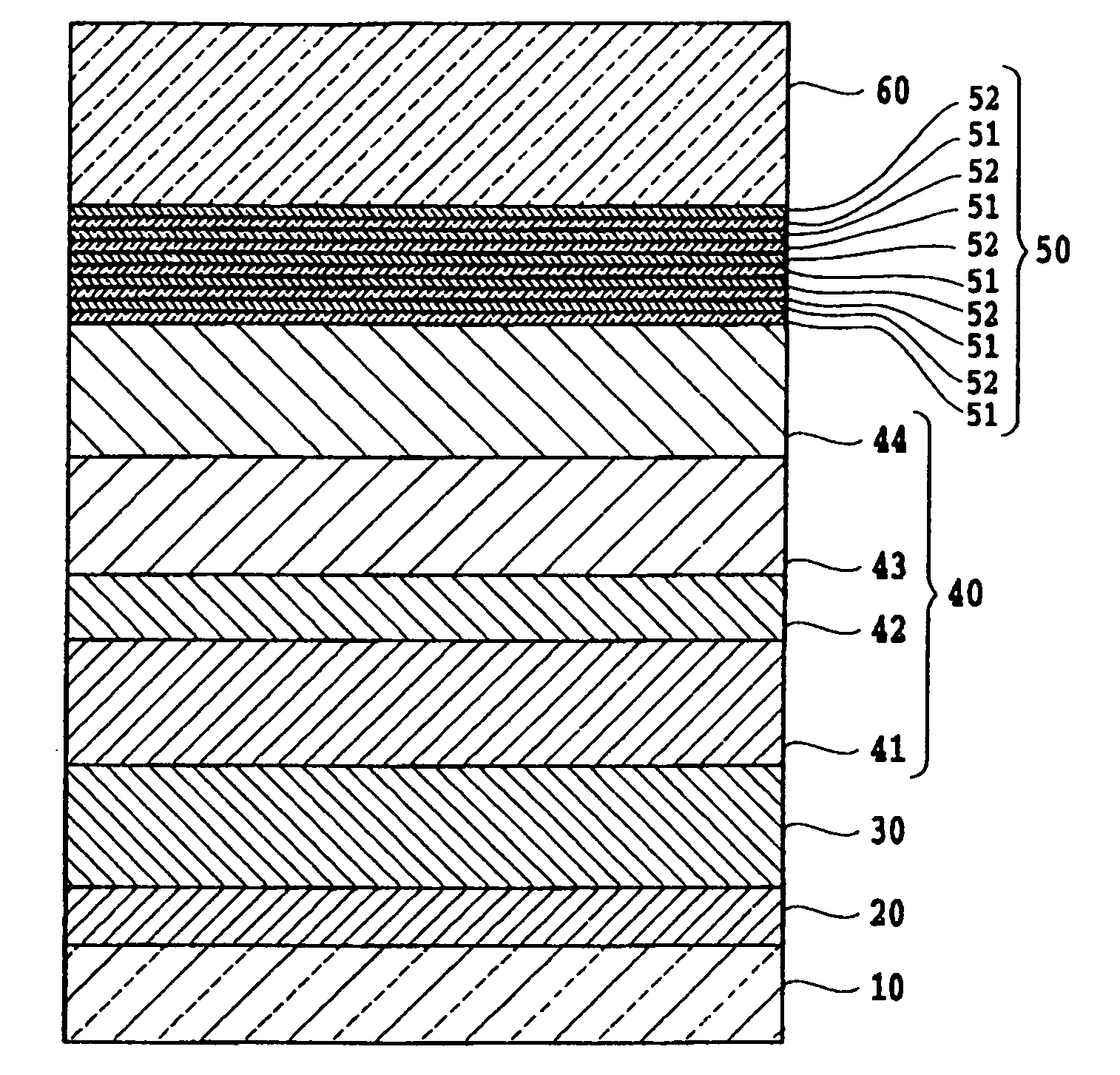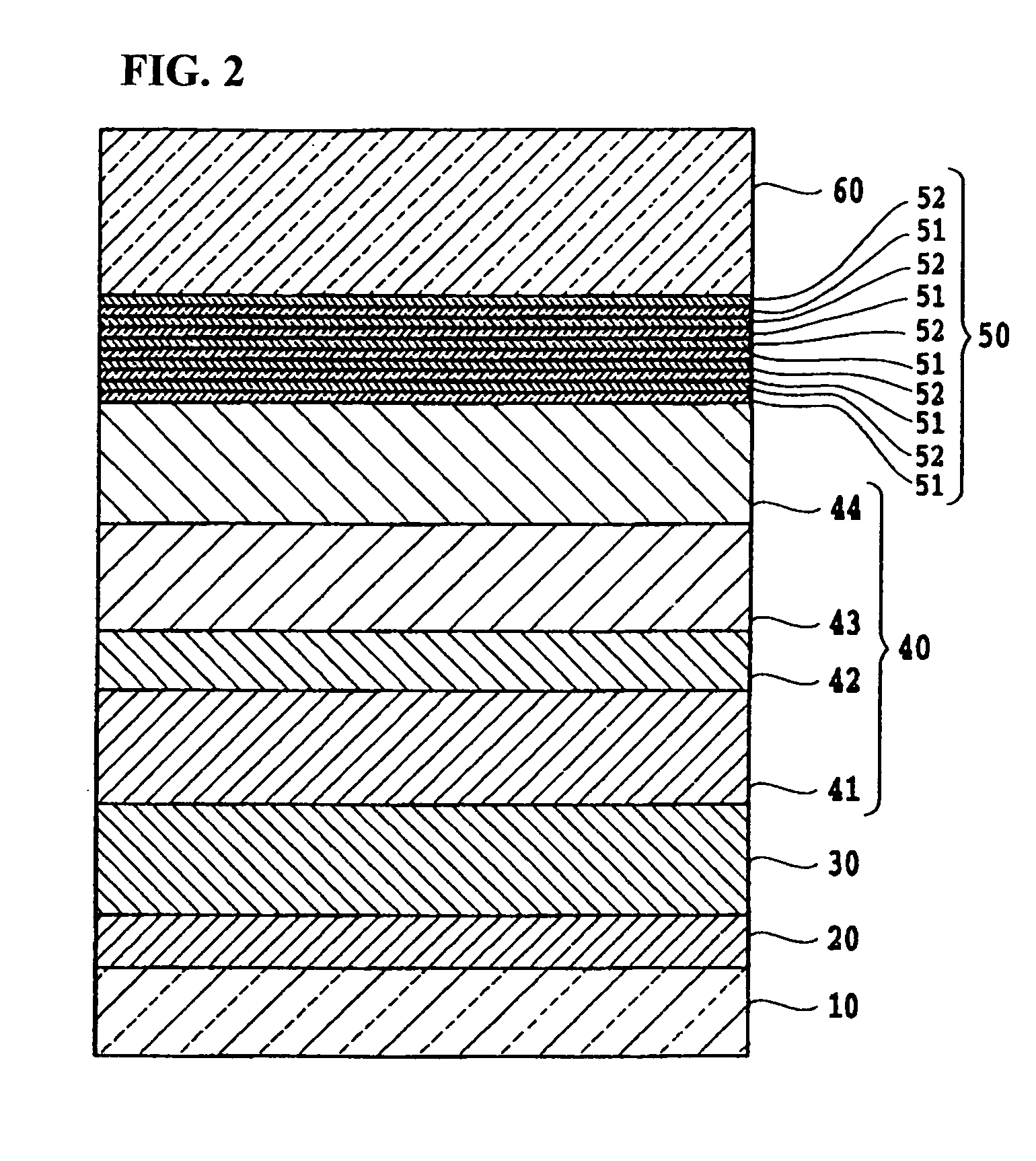Organic electroluminescent device and method for manufacturing same
a technology of electroluminescent devices and electroluminescent devices, which is applied in the direction of discharge tube luminescnet screens, natural mineral layered products, etc., can solve the problems of low stability, problems that have to be solved, and complicated driving circuits, etc., to achieve sufficient transmissivity and conductivity
- Summary
- Abstract
- Description
- Claims
- Application Information
AI Technical Summary
Problems solved by technology
Method used
Image
Examples
example 1
[0068]To evaluate the performance of buffer structures, samples having a multilayer buffer structure on an organic EL layer (electron transport layer) were fabricated. The buffer structure was composed of alternately laminated LiF layers (transparent material layers) and aluminum layers (metallic layers). The samples were fabricated using a three chamber type evaporation apparatus (including a load lock chamber, an organic chamber, and a metal chamber) through the procedure described below. The vacuum chamber was evacuated to 1×10−5 Pa. The evaporation source used was a resistance heating type. The material of the crucible was quartz, Mo, or BN corresponding to evaporation materials.
[0069]A glass substrate was moved into the organic chamber. An organic EL layer of Alq3 162 nm thick was deposited at a deposition rate of 2 Å / s on the glass substrate. The glass substrate having Alq3 layer thereon was moved to a metal chamber, and a LiF layer 1 nm thick was formed on the Alq3 layer at a...
example 2
[0077]An organic EL device having a buffer structure of a multilayer structure was manufactured as follows.
[0078]A CrB film 100 nm thick was deposited on a glass substrate. After patterning, the processes of drying (at 150° C.) and UV treatment (at room temperature and at 150° C.) were corducted to form a reflective electrode of CrB. Deposition of the CrB film was carried out by a DC sputtering method under room temperature using sputtering gas of argon supplying sputtering power of 300 W.
[0079]The glass substrate with the reflective electrode of CrB formed thereon in the previous steps was moved to an evaporation apparatus. The vacuum chamber was evacuated to 1×10−5 Pa. Holding the vacuum, an organic EL layer, a buffer structure, and a cathode were sequentially formed. The organic EL layer was comprised of a hole injection layer, a hole transport layer, an organic light emmisive layer, and an electron transport layer. The hole injection layer was formed by depositing copper phthalo...
example 3
[0087]An organic EL device having a multilayered buffer structure was manufactured in the same manner as in Example 2 except that the buffer structure consisting of 10 layers and having total thickness of 10 nm was formed by repeating five times the process of alternately laminating a LiF layer 0.5 nm thick and an aluminum layer 1.5 nm thick. Current density and luminance were measured by applying pulse voltage to the thus obtained organic EL device. The results are given in Table 3.
PUM
| Property | Measurement | Unit |
|---|---|---|
| thickness | aaaaa | aaaaa |
| work function | aaaaa | aaaaa |
| thickness | aaaaa | aaaaa |
Abstract
Description
Claims
Application Information
 Login to View More
Login to View More - R&D
- Intellectual Property
- Life Sciences
- Materials
- Tech Scout
- Unparalleled Data Quality
- Higher Quality Content
- 60% Fewer Hallucinations
Browse by: Latest US Patents, China's latest patents, Technical Efficacy Thesaurus, Application Domain, Technology Topic, Popular Technical Reports.
© 2025 PatSnap. All rights reserved.Legal|Privacy policy|Modern Slavery Act Transparency Statement|Sitemap|About US| Contact US: help@patsnap.com



